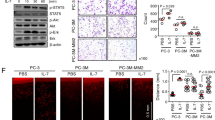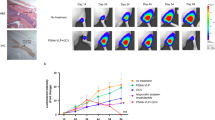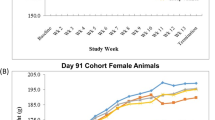Abstract
The purpose of this study was to determine the effects of interferon-β (IFN-β) gene transfer on the growth of PC3MM2 human prostate cancer cells in nude mice. Intralesional delivery of an adenoviral vector encoding murine IFN-β (AdIFN-β), but not a vector encoding bacterial β-galactosidase (AdLacZ), suppressed PC3MM2 tumors in a dose-dependent manner. At the highest dose (2×10 9 plaque-forming units, PFU), a single injection of AdIFN-β (but not AdLacZ) suppressed orthotopic PC3MM2 tumors and development of metastasis by 80%, and eradicated the tumors in 20% of mice. Immunohistochemical staining showed that AdIFN-β–treated tumors contained fewer microvessels, fewer proliferating cells, and more apoptotic cells than did the control tumors. Compared with controls, tumors injected with AdIFN-β expressed higher levels of IFN-β and inducible nitric oxide synthase (iNOS) and lower levels of basic fibroblast growth factor (bFGF) and transforming growth factor β1 (TGF-β1). In vitro analysis indicated that expression of bFGF and TGF-β1 in PC3MM2 cells could be suppressed by the nitric oxide donor sodium nitroprusside. These data suggest that intratumoral delivery of the IFN-β gene with adenoviral vectors could be an effective therapy for prostate cancer and that tumor suppression by AdIFN-β correlated with up-regulation of iNOS and down-regulation of angiogenesis. Cancer Gene Therapy (2001) 8, 497–505
This is a preview of subscription content, access via your institution
Access options
Subscribe to this journal
Receive 12 print issues and online access
$259.00 per year
only $21.58 per issue
Buy this article
- Purchase on Springer Link
- Instant access to full article PDF
Prices may be subject to local taxes which are calculated during checkout
Similar content being viewed by others
References
Landis SH, Murray T, Bolden S, et al . Cancer statistics, 1999 CA-Cancer J Clin 1999 49: 8–31,1
Sabiston DC Jr . Textbook of Surgery: the Biological Basis of Modern Surgical Practice Vol.1: 14th edn. Philadelphia: WB Saunders 1991 1470–1472
Hegarty NJ, Fitzpatrick JM, Richie JP, et al . Future prospects in prostate cancer Prostate 1999 40: 261–268
Mitsui Y, Senda T, Shimazu T, et al . Structural, functional and evolutionary implications of the three-dimensional crystal structure of murine interferon-beta Pharmacol Ther 1993 58: 93–132
Lokshin A, Mayotte JE, Levitt ML . Mechanism of interferon beta-induced squamous differentiation and programmed cell death in human non–small-cell lung cancer cell lines J Natl Cancer Inst 1995 87: 206–12
Belhumeur P, Lanoix J, Blais Y, et al . Action of spontaneously produced beta interferon in differentiation of embryonal carcinoma cells through an autoinduction mechanism Mol Cell Biol 1993 13: 2846–57
Qin XQ, Runkel L, Deck C, et al . Interferon-beta induces S phase accumulation selectively in human transformed cells J Interferon Cytokine Res 1997 17: 355–67
Gorlach A, Herter P, Hentschel H, et al . Effects of nIFN beta and rIFN gamma on growth and morphology of two human melanoma cell lines: comparison between two- and three-dimensional culture Int J Cancer 1994 56: 249–54
Fujihara M, Ito N, Pace JL, et al . Role of endogenous interferon-beta in lipopolysaccharide-triggered activation of the inducible nitric-oxide synthase gene in a mouse macrophage cell line, J774 J Biol Chem 1994 269: 12773–8
Riches DW, Underwood GA . Expression of interferon-beta during the triggering phase of macrophage cytocidal activation. Evidence for an autocrine/paracrine role in the regulation of this state J Biol Chem 1991 266: 24785–92
Fujimiya Y, Wagner RJ, Groveman S, et al . In vivo priming effects of interferon-beta ser on NK activity of peripheral blood mononuclear cells in cancer patients Ther Immunol 1995 2: 15–22
Senik A, Gresser I, Maury C, et al . Enhancement by interferon of natural killer cell activity in mice Cell Immunol 1979 44: 186–200
Brem H, Gresser I, Grosfeld J, et al . The combination of antiangiogenic agents to inhibit primary tumor growth and metastasis J Pediatric Surg 1993 28: 1253–7
Stout AJ, Gresser I, Thompson WD . Inhibition of wound healing in mice by local interferon alpha/beta injection Int J Exp Pathol 1993 74: 79–85
Singh RK, Gutman M, Bucana CD, et al . Interferons alpha and beta down-regulate the expression of basic fibroblast growth factor in human carcinomas Proc Natl Acad Sci USA 1995 92: 4562–6
Kaido T, Gresser I, Maury C, et al . Sensitized T lymphocytes render DBA/2 beige mice responsive to IFN alpha/beta therapy of Friend erythroleukemia visceral metastases Int J Cancer 1993 54: 475–81
Sarkar S, Flores I, De Rosa C, et al . Injection of irradiated B16 melanoma genetically modified to secrete IFN-α causes regression of an established tumor Int J Oncol 1995 7: 17–24
Kaido TJ . Intranasal administration of IFN-alpha/beta inhibits the development of visceral tumor metastases J Interferon Cytokine Res 1997 17: 31–6
Garaci E, Pica F, Mastino A, et al . Antitumor effect of thymosin alpha 1/interleukin-2 or thymosin alpha 1/interferon alpha,beta following cyclophosphamide in mice injected with highly metastatic Friend erythroleukemia cells J Immunother 1993 13: 7–17
Marrack P, Kappler J, Mitchell T . Type I interferon keep activated T cell alive J Exp Med 1999 189: 521–9
Luft T, Pang KC, Thomas E, et al . Type I IFNs enhance the terminal differentiation of dendritic cells J Immunol 1998 161: 1947–53
Jiang H, Dhib-Jalbut S . Differential induction of IL-12 by IFN-beta and IFN-gamma in human macrophages J Interferon Cytokine Res 1998 18: 697–703
Gutterman JU . Cytokine therapeutics: lessons from interferon-alpha Proc Natl Acad Sci USA 1994 91: 1198–1205
Wu JM, Lin CS, Wang JN, et al . Pulmonary cavernous hemangiomatosis treated with interferon alfa-2a Pediatr Cardiol 1996 17: 332–4
Shepherd FA, Beaulieu R, Gelmon K, et al . Prospective randomized trial of two dose levels of interferon alfa with zidovudine for the treatment of Kaposi's sarcoma associated with human immunodeficiency virus infection: a Canadian HIV Clinical Trials Network study J Clin Oncol 1998 16: 1736–42
Schiller JH, Storer B, Bittner G, et al . Phase II trial of a combination of interferon-beta ser and interferon-gamma in patients with advanced malignant melanoma J Interferon Res 1988 8: 581–9
Bulbul MA, Huben RP, Murphy GP . Interferon-beta treatment of metastatic prostate cancer J Surg Oncol 1986 33: 231–3
Einhorn S, Grander D . Why do so many cancer patients fail to respond to interferon therapy? J Interferon Cytokine Res 1996 16: 275–281
Ozzello L, Habif DV, DeRosa CM . Antiproliferative effects of natural interferon beta alone and in combination with natural interferon gamma on human breast carcinomas in nude mice Breast Cancer Res Treat 1990 16: 89–96
Bocci V, Carraro F, Naldini A, et al . Interferon levels in human pulmonary tumors are lower than plasma levels J Biol Regul Homeostatic Agents 1990 4: 153–6
Bocci V, Carraro F, Naldini A, et al . Distribution of human recombinant interferon-alpha 2 in rat plasma, liver, and experimental liver metastases Mol Biother 1990 2: 233–4
Salmon P, Le Cotonnec JY, Galazka A, et al . Pharmacokinetics and pharmacodynamics of recombinant human interferon-β in healthy male volunteers J Interferon Cytokine Res 1996 16: 759–64
Dong Z, Greene G, Pettaway C, et al . Suppression of angiogenesis, tumorigenicity, and metastasis by human prostate cancer cells engineered to produce interferon-beta Cancer Res 1999 59: 872–9
Lu W, Fidler IJ, Dong Z . Adenovirus-mediated interferon-beta gene therapy eradicates primary tumors and induces systemic immune protection in UV2237m murine metastatic fibrosarcoma Cancer Res 1999 59: 5202–8
Graham FL, Prevec L . Manipulation of adenovirus vectors In: Murray EJ, ed. Gene Transfer and Expression Protocols Vol. 7: New Jersey: Humana Press 1991 109–128
Kozlowski JM, Fidler IJ, Campbell D, et al . Metastatic behavior of human tumor cell lines grown in the nude mouse Cancer Res 1984 44: 3522–9
Stephenson RA, Dinney CP, Gohji K, et al . Metastatic model for human prostate cancer using orthotopic implantation in nude mice J Natl Cancer Inst 1992 84: 951–7
Gavrieli Y, Shermen Y, Ben-Sasson SA . Identification of programmed cell death in situ via specific labeling of nuclear DNA fragmentation J Cell Biol 1992 119: 493–501
Bruns CJ, Solorzano CC, Harbison MT, et al . Blockade of the epidermal growth factor receptor signaling by a novel tyrosine kinase inhibitor leads to apoptosis of endothelial cells and therapy of human pancreatic carcinoma Cancer Res 2000 60: 2926–35
Dong Z, Juang SH, Kumar R, et al . Suppression of tumorigenicity and metastasis in murine UV-2237 fibrosarcoma cells by infection with a retroviral vector harboring the interferon-beta gene Cancer Immunol Immunother 1998 46: 137–46
Wilson GD, Camplejohn RS, Martindale CA, et al . Flow cytometric characterisation of proliferating cell nuclear antigen using the monoclonal antibody PC10 Eur J Cancer 1992 12: 2010–7
Xu L, Xie K, Fidler IJ . Therapy of human ovarian cancer by transfection with the murine interferon beta gene: role of macrophage-inducible nitric oxide synthase Hum Gene Ther 1998 9: 2699–708
Xie K, Bielenberg D, Huang S, et al . Abrogation of tumorigenicity and metastasis of murine and human tumor cells by transfection with the murine IFN-beta gene: possible role of nitric oxide Clin Cancer Res 1997 3: 2283–94
Qin XQ, Tao N, Dergay A, et al . Interferon-beta gene therapy inhibits tumor formation and causes regression of established tumors in immune-deficient mice Proc Natl Acad Sci USA 1998 95: 14411–6
RayChaudhury A, Frischer H, Malik AB . Inhibition of endothelial cell proliferation and bFGF-induced phenotypic modulation by nitric oxide J Cell Biochem 1996 63: 125–34
Xie K, Huang S, Dong Z, et al . Destruction of bystander cells by tumor cells transfected with inducible nitric oxide (NO) synthase gene J Natl Cancer Inst 1997 89: 421–7
Li LM, Kilbourn RG, Adams J, et al . Role of nitric oxide in lysis of tumor cells by cytokine-activated endothelial cells Cancer Res 1991 51: 531–5
Li LM, Nicolson GL, Fidler IJ. . Direct in vitro lysis of metastatic tumor cells by cytokine-activated murine vascular endothelial cells Cancer Res 1991 51: 245–54
Xie K, Dong Z, Fidler IJ . Activation of nitric oxide synthase gene for inhibition of cancer metastasis J Leukocyte Biol 1996 59: 797–803
Lee C, Sintich SM, Mathews EP, et al . Transforming growth factor-beta in benign and malignant prostate Prostate 1999 39: 285–90
Sintich SM, Lamm ML, Sensibar JA, et al . Transforming growth factor-beta1–induced proliferation of the prostate cancer cell line, TSU-Pr1: the role of platelet-derived growth factor Endocrinology. 1999 140: 3411–5
Wolff JM, Fandel TH, Borchers H, et al . Serum concentrations of transforming growth factor-beta 1 in patients with benign and malignant prostatic diseases Anticancer Res 1999 19: 2657–9
Wolff JM, Fandel T, Borchers H, et al . Transforming growth factor-beta1 serum concentration in patients with prostatic cancer and benign prostatic hyperplasia Br J Urol 1998 81: 403–5
Festuccia C, Giunciuglio D, Guerra F, et al . Osteoblasts modulate secretion of urokinase-type plasminogen activator (uPA) and matrix metalloproteinase-9 (MMP-9) in human prostate cancer cells promoting migration and matrigel invasion Oncol Res 1999 11: 17–31
Festuccia C, Angelucci A, Gravina GL, et al . Osteoblast-derived TGF-beta1 modulates matrix degrading protease expression and activity in prostate cancer cells Int J Cancer 2000 85: 407–15
Lagadec P, Raynal S, Lieubeau B, et al . Evidence for control of nitric oxide synthesis by intracellular transforming growth factor-beta1 in tumor cells. Implications for tumor development Am J Pathol 1999 154: 1867–76
Rieger J, Stander M, Loschmann PA, et al . Synthesis and biological effects of NO in malignant glioma cells: modulation by cytokines including CD95L and TGF-beta, dexamethasone, and p53 gene transfer Oncogene 1998 17: 2323–32
Acknowledgements
We thank Dr. Isaiah J. Fidler for advice on our research, Dr. Corazon D. Bucana, Donna Reynolds, and Yunfang Wang for technical assistance with immunohistochemical staining, Jacob Lyons for assistance with preparation of adenoviral vectors, and Walter Pagel for critical editorial comments. This study was supported in part by funds from Cancer Center Support Core Grant CA16672 and Grant RPG-98-332 from the American Cancer Society (to Z.D.).
Author information
Authors and Affiliations
Corresponding author
Rights and permissions
About this article
Cite this article
Cao, G., Su, J., Lu, W. et al. Adenovirus-mediated interferon-β gene therapy suppresses growth and metastasis of human prostate cancer in nude mice. Cancer Gene Ther 8, 497–505 (2001). https://doi.org/10.1038/sj.cgt.7700333
Received:
Published:
Issue Date:
DOI: https://doi.org/10.1038/sj.cgt.7700333
Keywords
This article is cited by
-
Antitumor activity of interferon-β1a in hormone refractory prostate cancer with neuroendocrine differentiation
Journal of Endocrinological Investigation (2017)
-
Using lentiviral vectors for efficient pancreatic cancer gene therapy
Cancer Gene Therapy (2010)
-
Oncolytic measles viruses encoding interferon β and the thyroidal sodium iodide symporter gene for mesothelioma virotherapy
Cancer Gene Therapy (2010)
-
Preventing Growth of Brain Tumors by Creating a Zone of Resistance
Molecular Therapy (2008)
-
Local gene delivery of tumor necrosis factor alpha can impact primary tumor growth and metastases through a host-mediated response
Clinical & Experimental Metastasis (2007)



